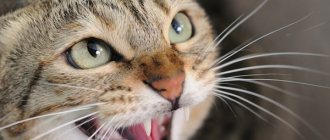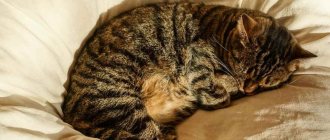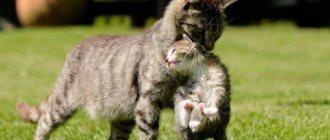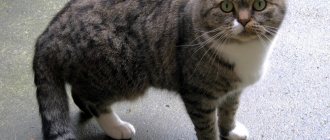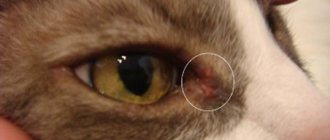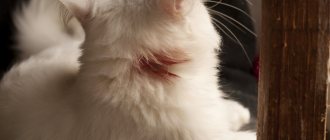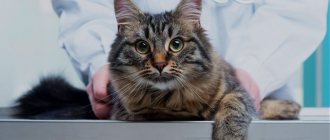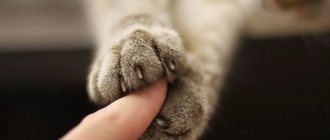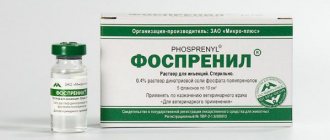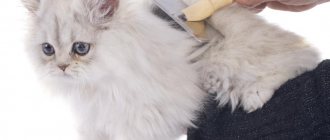Is your cat overweight? Should you worry?
We often don't have enough time to walk and play with our furry friend.
Cats sit locked up, alone. Together with poor nutrition, this leads to weight gain and then obesity. Excess weight and obesity provoke the development of serious diseases. The length and quality of life of the cat decreases. Most owners do not realize that their pet is overweight. In this article we will tell you why obesity is dangerous, how to help your pet if it occurs, and how to prevent its occurrence.
What is obesity and why is it dangerous for your cat?
Obesity is a disease associated with metabolic disorders. It manifests itself as excessive accumulation of fat in subcutaneous tissue, organs and tissues.
Many domestic cats are overweight. It causes serious health problems and increases the risk of serious diseases: diabetes, heart and vascular diseases, pancreas, liver, urolithiasis, arthritis. Let's talk about the most unpleasant of them in more detail:
- Diabetes mellitus
Excess weight and obesity can trigger the development of diabetes mellitus in a cat. In obese animals, the functioning of the pancreas and the production of the hormone insulin are disrupted. - Diseases of the heart and blood vessels
Fatty deposits in the form of plaques form on the walls of blood vessels, and atherosclerosis develops. The vessels become hard, inelastic, and narrow. Blood access to organs is reduced, and the risk of thrombosis increases. Fatty degeneration of the heart and atherosclerosis are the main causes of the development of cardiovascular failure in an obese animal. - Fatty degeneration of organs
When there is an excess of calories, fat in cats is deposited not only on the ribs and abdomen, but also on the internal organs. This can lead to fatty degeneration of the liver, kidneys, heart, and pancreas. - Urolithiasis
Obese cats are predisposed to the formation of kidney and bladder stones and the development of urolithiasis. - Joint diseases
In fat cats, the load on the musculoskeletal system increases. Joints become inflamed and deformed. Arthritis develops, which can turn into arthrosis. Obese cats move less, lie down more, and have difficulty standing up.
Animals that are overweight are less able to tolerate anesthesia and surgery. Fat cats often experience infertility and complications during childbirth.
What is fat tail
A cat has a fat tail - a medium-sized pouch of skin and fat on the abdomen. It happens in dogs too. Scientifically called the primordial or rudimentary sac.
In long-haired individuals, the fur hides the belly, so the tail is inconspicuous. The short-haired cat and the Sphynx have a pronounced skin formation.
The cat's belly hangs from behind, in the area of its hind legs. The thickness of the fat tail is determined by the fat layer and varies.
Sagging should not exceed 5 cm, otherwise internal pathologies should be suspected.
Domestic cats inherited their fat tails from their wild relatives. In the latter, the sagging of the abdomen is pronounced; the bag sways noticeably when walking and jumping. And in domestic cats, a hanging tummy can be almost invisible. The volume of the fat tail varies by season: in spring and summer the fat layer decreases, in the cold period fat increases.
Reasons for appearance
The exact causes of the appearance of a skin-fat pouch in cats have not been established. Scientific research confirms that functionally the fat tail is an important formation provided for by evolution:
- The stomach of cats is a vulnerable part of the body that is not protected by the skeleton, and abdominal injuries and pathologies are deadly. Scientists believe that the skin bag with a fat layer is a protective formation. Thanks to the fat tail, a cat sneaking during the hunt does not risk scratching or piercing its belly with a sharp branch or stone.
- There is another idea why cats need a primordial sac: it is a storehouse of nutrients. The theory is confirmed by the fact that the fat tail is most noticeable in obese cats, decreases in the summer heat, and increases in the cold season, when the body accumulates fats to prevent winter hunger. In nature, with a prolonged absence of prey, the body begins to consume nutrients from the abdominal pouch.
- The third probable cause of sagging belly is the way cats move. The skeleton of predators is flexible and mobile. During the hunt, the joints of the limbs are stretched, the spinal column bends vertically and horizontally at a significant angle. For freedom of body movements, elasticity and folding of the skin is necessary. The fat tail allows you to bend your spine as much as possible.
- The protective function of the fat tail may be to prevent injury to the abdominal organs during territorial fights with relatives. Cats that are grappling tend to strike hard with their hind paws in the area of the opponent's stomach, tearing the skin with their claws. The fat tail protects the abdominal organs from serious injury.
Why do pets get fat?
1. Unbalanced feeding
A common cause of obesity in a pet is improper feeding.
Mistakes the owner makes when planning his pet’s diet:
- Overfeeding;
- High calorie diet;
- Mixed type of feeding;
- Harmful treats in the diet;
- Encouraging begging.
2. Passive lifestyle
Many cats constantly stay at home, their activity is limited by the area of the apartment. A pet's sedentary lifestyle and unbalanced feeding lead to weight gain in the pet.
3. Metabolic disorders
Obesity occurs in diseases associated with metabolic disorders. Obesity is often associated with hormonal changes. With a lack of hormones from the pituitary gland, adrenal glands, thyroid and pancreas, fat metabolism is disrupted, which leads to excessive fat deposition in the organs and tissues of the pet.
4. Breed predisposition
Some cat breeds are predisposed to obesity. If you are the owner of a Scottish, Himalayan, British, or Persian cat, pay special attention to the calorie intake and mobility of your pet.
5. Age
Older cats are more prone to obesity than younger cats. With age, animals, like humans, slow down their metabolism and decrease their activity. Excess calories are stored as fat on the sides and stomach.
6. Castration
The energy requirement of castrated animals is significantly reduced. If you continue to feed your cat after castration the same food and in the same quantity, this will lead to weight gain and obesity. After surgery, use a low-calorie, low-fat diet.
Treatment
If you don’t know what to do if your pet has sudden bloating, first, with the help of a veterinarian, determine the cause of this pathology. Recommended treatment methods depend on an accurate diagnosis.
To normalize the functioning of a cat’s stomach, a specialist can advise adjusting its diet, increasing physical activity and proper daily care. For constipation, animals are given warm water enemas. If a cat suffers from helminths, anthelmintic medications are used in therapy. To prevent the re-development of helminthiasis, preventive deworming should be carried out regularly.
In cases where the animal has accumulated fluid in the body, it is necessary to increase the frequency of urination. For this purpose, cats are given diuretics. With the development of severe forms of ascites, fluid is pumped out from the peritoneum using a syringe and a special needle. A number of pathologies that cause enlargement of the abdominal cavity can only be eliminated surgically.
All information posted on the site is provided in accordance with the User Agreement and is not a direct instruction to action. We strongly recommend that before using any product, you must obtain a face-to-face consultation at an accredited veterinary clinic.
How do you know if your pet is overweight or obese?
Obesity in cats is a metabolic disorder that leads to the accumulation of excess fatty tissue. We can talk about obesity if a cat’s body weight is increased by 15-20% of the average data for breed, sex and age. A cat's weight at 1 year of age is considered ideal and should be maintained throughout its life.
Signs of obesity:
- Sagging belly;
- Fat deposits on the sides;
- Loose, leisurely gait;
- Increased fatigue;
- Apathy and drowsiness;
- Dyspnea.
Fat in cats is primarily deposited in the lower abdomen and sides. Feel your pet carefully. If his ribs cannot be felt and there is a thick fold of fat in the lower abdomen, the pet is overweight.
Changes in muscle tone during pregnancy
In most cases, pregnancy in cats is easy. The cat does not feel any discomfort, but is reluctant to be handled and strains its abdominal muscles when trying to feel it. A very hard belly in a cat may indicate a pathologically developing pregnancy. This condition ends in miscarriage and is accompanied by changes in the pet’s behavior - she refuses to eat, drinks a lot, behaves restlessly and constantly meows.
If your cat has a hard belly after giving birth, you should take the animal to the vet as soon as possible. This is a dangerous sign indicating the development of pyometra. This disease is caused by the penetration of pathogenic bacteria into the uterine cavity. Pyometra is accompanied by profuse suppuration, which can be caused by infection of the uterus during delivery.
Symptoms of a dangerous disease:
- Hard and swollen abdomen.
- Refusal of food.
- Increased thirst.
- Increased body temperature.
- General deterioration in health.
With pyometra, veterinarians insist on surgical removal of the uterus and appendages. A timely detected disease can be successfully treated with antibiotics, but only at the beginning of the development of the pathological process.
What to do if your pet is obese?
If your pet is overweight, contact your veterinarian. It will help you find out the causes of this problem. The doctor will take blood and urine tests to rule out serious hormonal disorders.
After the research, the doctor will prescribe a diet for your cat. She must lose weight gradually. Feed your pet 2-3 times a day in small portions of low-calorie, low-fat food. There are special ready-made foods for obese animals.
Provide physical activity for your pet. Play with it daily, gradually increasing the load and duration of games.
Closely monitor your pet's weight changes and regularly take him to see your veterinarian.
Obesity that occurs as a result of other diseases is more difficult to cope with. Doctors prescribe specific treatment for each specific case.
Preventive actions
To prevent the pet from encountering a problem such as bloating, its owner must take care of the prevention of diseases that cause this symptom. The most effective protective measures in this case are:
- The right diet. A consultation with a veterinarian will allow you to select a diet taking into account the age, health status and individual needs of a particular cat. Its owner will only have to make sure that the animal does not overeat and always has access to drinking water and does not receive poorly cooked meat or fish (such products may contain parasites).
- Insulation. An animal that is constantly in the apartment has less chance of contracting an infection or picking up worms. Lack of contact with other cats and walks in the fresh air will not harm your pet (unlike open windows, through which disease carriers - insects - can enter the house, and the pet itself can jump out and get injured by landing carelessly on the ground).
- Special medications. Anyone, even a domestic animal, must undergo preventive treatment for worms once every 3 months. For this purpose, special tablets are sold in pharmacies. Vaccinations against common cat infections are done less frequently - once a year.
Hello, the problem is very urgent. The cat stopped eating, drinking water, but when force-fed, he went to the toilet well. He became very lethargic, hiding in a dark place. The belly has increased in size, looks like the belly of a pregnant cat, but it is soft and the cat is not indignant when palpated. Temperature 38.4. Help me understand what is happening. Let me clarify that the cat was neutered last year, vaccinated in April last year and dewormed this April. Last year, an operation was performed to remove a foreign object from the intestines. The cat is 2 years old and cannot go outside.
On the Ask a Doctor service, you can consult a veterinarian on any problem that concerns you. Expert doctors provide consultations around the clock and free of charge. Ask your question and get an answer immediately!
Prevent your pet from becoming obese
Obesity is easier to prevent than to treat. To prevent your cat from gaining excess weight, follow these recommendations:
- Don't overfeed your pet;
- Monitor the quality of the feed;
- Do not mix different types of food (dry and natural);
- Provide regular physical activity.
Obesity is a common problem and affects many pets. However, the owner has every chance to prevent the development of the disease or cope with an existing disease. We hope that our tips will help your pet always stay healthy and active.
